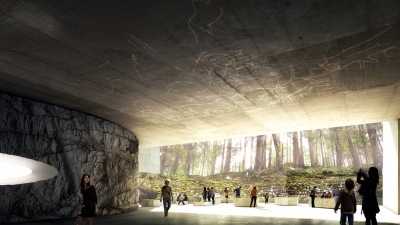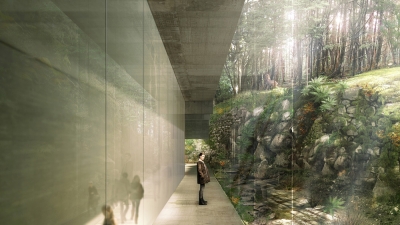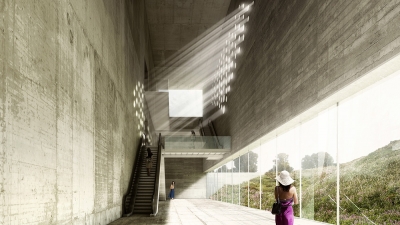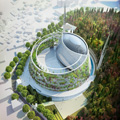
Project: Lascaux IV: International Cave Painting Center Competition Entry
Designed by Mateo Arquitectura
Author: Josep Lluís Mateo
Scenography: Projectiles
Landscape: D’ici-la
Multimedia: Reciproque
BET TCE: Setec Bâtiment
Acoustics: Commins acoustics workshop
Location: Montignac – Lascaux, Dordogne, France
Website: www.mateo-maparchitect.com
The proposal for the Lascaux IV: International Cave Painting Center coming from the drawing board of Mateo Arquitectura. Get familiar with the project after the jump:
From the Architects:
The Conseil Général de la Dordogne (France) recently organized a competition for the construction of Lascaux IV, a complete scale replica of the Lascaux cave, at Montignac, at the foot of the hill where the actual cave is situated.
The project is explained below in this introductory text by the team led by Josep Lluís Mateo.
“…any one who has common sense will remember that the bewilderments of the eyes are of two kinds, and arise from two causes, either from coming out of the light or from going into the light.”
A gentle slope leads us into the earth and gradually accustoms our eyes to the dark.
There … we are inside. Our only contact with the outside is the presence close by of the hill, an enduring mass that guards the treasure within. Then there is the wood and, more vaguely, the sky.
The rock offers the invitation of a light-filled breach. It calls to us, to enter. To experience history as it happened-that of the most spiritual discovery of the century. By way of a prelude, a long descent bordered by a mutant landscape leads us to the entrance to the cave, under the taiga of the ice age.
The cave opens up to us. It lights up the timeless beauty of the raised figures with a tremulous light as we pass, fading away behind us.
As we leave the cave, our shadows flicker in an ascending movement towards the daylight. Further on, the sun guides our steps to the upper level.
Up there is another Lascaux-one that presents its walls as monolithic figures overlooking landscapes of yesterday and today; one that is presented to our understanding, that invites us to live the experience, to do the right thing; one that shows us what is concealed and reveals to us its secret. It speaks to us of its history, woven of enigmas that humankind seeks to solve. It tells us that there are individuals who think, who prove, who suppose and interpret. Right beside, their virtual doubles welcome us in small theatres sunk into the ground, facing the hill. Here, the staging employs a poetic dialogue between archaic matter and intangible technology. It extends the masterly gesture of the anonymous artist.
To build this architecture, you have to open up the earth delicately, tread carefully on the hill, raise strong walls and lay down thick slabs. You approach these operations with a primary logic, both archaic and contemporary. You touch the ground attentively, letting groundwater follow its course. The walls and the structures are minimum, simple, and sitespecific: they have a tectonic presence.
Outwardly, the building expresses a telluric force. Its mineral quality resembles that of the Castle, or of the bridge over the river Vézère.
The object of the space is to convey the emotion of Lascaux, the presence close at hand of something that is distant and elusive. Here, “We must read the past as a future waiting to be discovered”.






